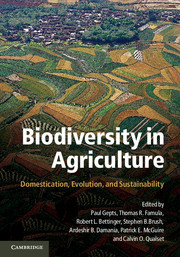Book contents
- Frontmatter
- Contents
- Tables
- Figures
- Foreword
- Contributors
- Acknowledgments
- Introduction: The Domestication of Plants and Animals: Ten Unanswered Questions
- 1 The Local Origins of Domestication
- Section I Early Steps in Agricultural Domestication
- Section II Domestication of Animals and Impacts on Humans
- Section III Issues in Plant Domestication
- Section IV Traditional Management of Biodiversity
- 17 Ecological Approaches to Crop Domestication
- 18 Agrobiodiversity Shifts on Three Continents Since Vavilov and Harlan: Assessing Causes, Processes, and Implications for Food Security
- 19 Indigenous Peoples Conserving, Managing, and Creating Biodiversity
- 20 Land Architecture in the Maya Lowlands: Implications for Sustainability
- 21 Agrobiodiversity and Water Resources in Agricultural Landscape Evolution (Andean Valley Irrigation, Bolivia, 1986 to 2008)
- Section V Uses of Biodiversity and New and Future Domestications
- Index
- References
21 - Agrobiodiversity and Water Resources in Agricultural Landscape Evolution (Andean Valley Irrigation, Bolivia, 1986 to 2008)
Published online by Cambridge University Press: 05 June 2012
- Frontmatter
- Contents
- Tables
- Figures
- Foreword
- Contributors
- Acknowledgments
- Introduction: The Domestication of Plants and Animals: Ten Unanswered Questions
- 1 The Local Origins of Domestication
- Section I Early Steps in Agricultural Domestication
- Section II Domestication of Animals and Impacts on Humans
- Section III Issues in Plant Domestication
- Section IV Traditional Management of Biodiversity
- 17 Ecological Approaches to Crop Domestication
- 18 Agrobiodiversity Shifts on Three Continents Since Vavilov and Harlan: Assessing Causes, Processes, and Implications for Food Security
- 19 Indigenous Peoples Conserving, Managing, and Creating Biodiversity
- 20 Land Architecture in the Maya Lowlands: Implications for Sustainability
- 21 Agrobiodiversity and Water Resources in Agricultural Landscape Evolution (Andean Valley Irrigation, Bolivia, 1986 to 2008)
- Section V Uses of Biodiversity and New and Future Domestications
- Index
- References
Summary
This chapter examines the evolution of agricultural landscapes that involve the interactions of agrobiodiversity and water resources. My goal is to identify and evaluate the environmental flows and human–environment management connections, referred to here as “linkages”, between these two types of resource use within dynamically evolving agricultural landscapes that incorporate crop irrigation. My analysis is focused on key processes and spatial patterns of landscape connections (involving human activities was well as crop, water, soil, and vegetation components) and, also, on determination of the limitations that constrain each of the primary links. This topic holds increased importance due to the landscape transformations that increasingly determine the viability of agrobiodiversity (Wood and Lenné 1999, Brush 2004). One prime example, and the focus of this presentation, is landscape evolution consisting of agrobiodiversity in contexts of irrigated agriculture (Zimmerer 2010a,b). Many such changes are propelled through major shifts in policies of water resource management (e.g., the partial end of the “big dam” era described below), as well as the expanding impacts on water resources resulting from climate change and energy resource development (WCD 2002).
The chapter begins by introducing the three elements of a proposed framework for evaluation of the ongoing evolution of agrobiodiversity dynamics within irrigated landscapes. These elements are (i) agrobiodiversity and irrigated landscapes; (ii) water resource management and current irrigation development policy; and (iii) landscape-based analysis of spatial parameters.
- Type
- Chapter
- Information
- Biodiversity in AgricultureDomestication, Evolution, and Sustainability, pp. 464 - 474Publisher: Cambridge University PressPrint publication year: 2012



